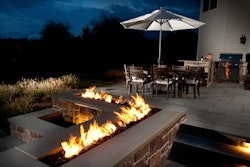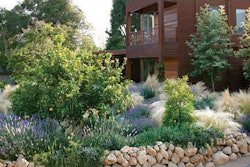How Smart are New Smart Controllers?
When put to the test, these irrigation controllers prove water wise.
By Billy R. Sims
In the beginning, there was heaven and earth. Rain came as part of the package.
Whenever this proved insufficient, humans employed various technologies to water crops and landscapes — irrigation canals, pumps and so on.
Resourceful, but not very efficient.
Rain Bird ESP-SMT
With the introduction of automatically controlled irrigation systems in the late 1950s, where water is distributed through pipes in predetermined patterns, a giant leap forward was achieved. Then changes came rapidly with the introduction of two-wire irrigation systems 25 years ago, followed by central controlled systems, and 10 years ago, ET or seasonally adjusted systems.
Within the past five years, a new generation of “smart” irrigation controllers has gained popularity. “Technology developed for the golf business has moved over to commercial and then residential applications,” says Doug Callison, senior product manager for Rain Bird.
Smart controllers are basically irrigation clocks that automatically adjust irrigation run times in response to environmental changes. They use sensors and weather information to manage watering times and frequency. As conditions vary, the controller increases or decreases irrigation.
Pretty darn smart, but what’s really intelligent: They reduce water use 15 to 30 percent and over-watering.
They are poised to change the face of landscape irrigation.
High IQs
Following are examples of controllers that have undergone Smart Water Technology (SWAT) performance tests by the Center for Irrigation Technology:
Rain Bird ESP-SMT
• Suitable for residential and light commercial landscapes
• Includes controller and onsite sensor to monitor weather conditions
• Sensor features tipping rain bucket that suspends irrigation if rainfall detected
• Sensor measures the amount of effective rainfall to prevent over-and under-watering
• Data link: two quick-connect, low-voltage terminals
• Zones: four-station base expands to 13 stations
• Calculates schedules based on zone-specific parameters (plant, soil, slope, sprinkler type)
• Cost: SRP $208-232
Weathermatic Smartline 1600
• Suitable for residential and light commercial
• Includes controller. On-site weather monitors (wired or wireless) optional
• Data source: on-site weather monitor
• Data link: direct low-voltage wire or wireless
• Zones: 4-16 to 12-48 zone models
• Calculates schedules based on zone-specific parameters (plant, soil, slope, sprinkler type)
• Built-in valve locator feature
• Cost: SRP $194.95
ET Water HermitCrab
• Suitable for commercial, municipal and residential landscapes
• This add-on unit converts conventional controller to web-connected smart system through remote access port
• Self-adjusting irrigation schedules based on local weather
• Data source: 9,000 professional weather stations across U.S. provide daily weather data
• Link: Wireless cell modem
• Zones: Up to 48 stations
• Full remote management through ET web application
• Cost: SRP $850









